
Phalaris arundinacea, or reed canary grass, is a tall, perennial bunchgrass that commonly forms extensive single-species stands along the margins of lakes and streams and in wet open areas, with a wide distribution in Europe, Asia, northern Africa and North America. Other common names for the plant include gardener's-garters in English, alpiste roseau in French, rohrglanzgras in German, kusa-yoshi in Japanese, caniço-malhado in Portuguese, and hierba cinta and pasto cinto in Spanish.
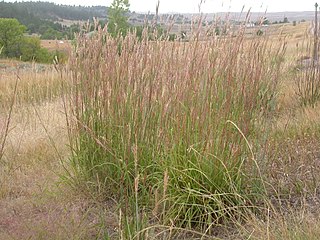
Andropogon gerardi, known commonly as big bluestem, turkeyfoot, tall bluestem, and bluejoint, is a species of tall grass native to much of the Great Plains and grassland regions of central and eastern North America.
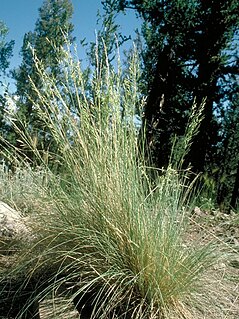
Festuca arizonica, commonly called Arizona fescue, is a grass found in western North America, in the southwest United States and northern Mexico. This species also has the common names mountain bunchgrass and pinegrass.

Parapholis incurva is a species of grass native to Europe, Asia and northern Africa, and widely naturalised elsewhere. Common names include coast barbgrass, curved sea hard grass, curved hard-grass, sicklegrass, curved sicklegrass and curved parapholis.

Diarrhena americana, also known as American beak grass or American beakgrain, is a native, perennial bunchgrass of North America.
Limnodea, with the common name Ozark grass, is a genus of North American plants in the grass family. The type species is Greenia arkansanaNutt..

Elymus virginicus, or Virginia wildrye, is a perennial bunchgrass located in Virginia and the eastern United States. Virginia wild rye is one of the few cool season native grasses found in the east Texas area. It is extremely palatable to livestock and will decrease without proper grazing management. It spreads via seed and tillering. It can be confused with Canadian wild rye which is a more robust plant with longer awns. It should be cut early in the season when used for hay to avoid ergot contamination. Northern Missouri Germplasm Virginia wild rye was released in 1999 by the Missouri Plant Material Center for use in northern Missouri.

Pappophorum is a genus of plants in the grass family, native to the Western Hemisphere. Members of the genus are commonly known as pappusgrass.

Andropogon hallii is a sod-forming perennial species in the grass family, Poaceae. It is a bunchgrass which grows in tufts and can reach 7 feet in height under favorable conditions.

Puccinellia nuttalliana is a species of grass known by the common name Nuttall's alkaligrass. It is native to North America, where it is widespread from Alaska east throughout Canada to Greenland, and common in the western and central United States. It is present in the Arctic, throughout the temperate mountain ranges, the Great Plains, the Great Basin, and along the western coastline of North America down through California.

Lespedeza bicolor is a species of flowering plant in the legume family known by the common names shrubby bushclover, shrub lespedeza, and bicolor lespedeza. It is native to Asia and it is widely grown as an ornamental plant. In some regions, such as the southeastern United States, it grows in the wild as an introduced and invasive species.
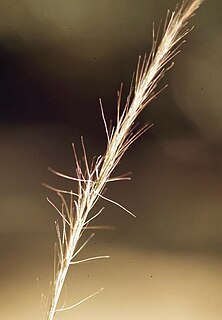
Aristida purpurascens is a species of grass known by the common name arrowfeather threeawn. It is native to eastern North America. One of the three varieties has a distribution extending south into Honduras.
Eriochloa sericea is a species of grass known by the common name Texas cupgrass. It is native to Nebraska, Kansas, Oklahoma, and Texas in the United States and to northern Mexico.
Muhlenbergia reverchonii is a species of grass known by the common name seep muhly. It is native to Oklahoma and Texas in the United States.
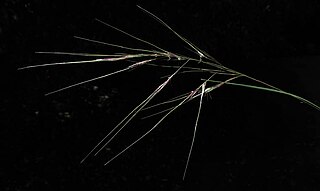
Nassella cernua is a species of grass known by the common name nodding needlegrass.

Panicum anceps is a species of grass known by the common name beaked panicgrass. It is native to the southeastern United States, where it occurs as far north as New Jersey and as far west as Kansas and Texas.

Pappophorum vaginatum is a species of grass known by the common name whiplash pappusgrass. It is native to the Americas, where it occurs in Arizona, Texas, northern Mexico, and part of South America extending from Uruguay to Argentina.

Sporobolus junceus is a species of grass known by the common name pineywoods dropseed. It is native to the southern United States.
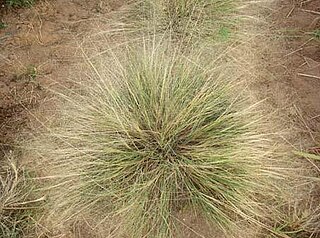
Sporobolus texanus is a species of grass known by the common name Texas dropseed. It is native to the western United States.
Sporobolus wrightii is a species of grass known by the common names big sacaton and giant sacaton. It is native to the western United States and northern and central Mexico.

















